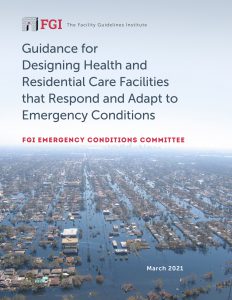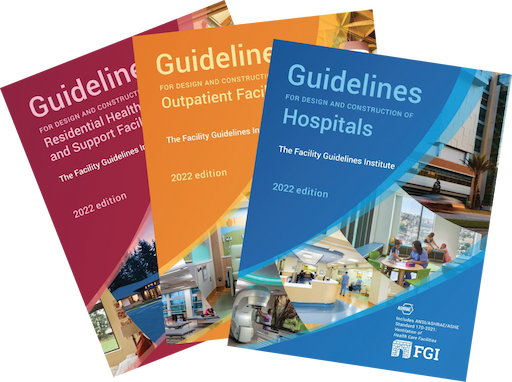FGI Releases Emergency Conditions Paper, Opens Comment Period for Draft Emergency Conditions Guidelines

The Facility Guidelines Institute (FGI) is pleased to announce the release of “Guidance for Designing Health and Residential Care Facilities that Respond and Adapt to Emergency Conditions“. This white paper, which includes the draft Guidelines for Emergency Conditions in Health and Residential Care Facilities, is the result of a collaboration of 130 volunteers representing multiple disciplines in health care, residential care, and facility design. FGI CEO and Emergency Conditions Committee Chair Douglas S. Erickson acknowledges, “This effort reflects thousands of hours of work by the diverse volunteer members of FGI’s Emergency Conditions Committee, other subject matter experts, and the FGI staff.”
The COVID-19 pandemic brought an influx of requests to FGI to provide practical guidance on setting up temporary facilities and adapting existing facilities to meet the particular needs of the pandemic. In response to these queries, the FGI Board of Directors formed a committee to take a critical look at existing Guidelines requirements and recommendations on emergency preparedness, determine best practices, and establish a new minimum standard on emergency preparedness and response for health and residential care facilities. The overarching goal of the white paper is to help health and residential care organizations respond to emergency events and plan mitigation strategies in anticipation of future emergency events.
Subcommittees to the Emergency Conditions Committee were formed under the topics of risk assessment, surge capacity, alternate care sites, modular facilities, operational considerations, resiliency, renovation and future facility design, small and/or rural health care facilities, and residential care facilities. A wide range of temporary and long-term solutions for the design and operation of health and residential care facilities was identified, informed both by lessons learned from previous local and national emergencies and practices currently being implemented in the field.
Highlights by chapter
- Risk Assessments. Included in this chapter is the proposed framework for a disaster, emergency, and vulnerability assessment. This assessment folds neatly into the existing safety risk assessment requirements in the Guidelines and leverages information in CMS-mandated hazard vulnerability assessments.
- Surge Capacity Considerations. This chapter covers an array of surge-related topics, including conversion of exterior areas to support spaces, considerations for building access during an emergency event, repurposing of existing spaces (such as conversion of a PACU to an ICU) to support appropriate levels of patient care during a surge event, PPE storage and supply, and medical gas system expansion.
- Alternate Care Sites. Considerations for use of tents, modular facilities, and repurposed structures as alternate care sites are outlined in this chapter. In addition to exploring how and when an alternate care site may be deployed, a downloadable compliance matrix tool is provided on the FGI website to assist with compliance strategies for short-term, intermediate, and long-term alternate care site solutions for patient surge events.
- Resiliency. This chapter addresses the ways in which health and residential care organizations can plan for resiliency in the face of various weather and man-made emergency events (e.g., chemical, biological, or radiological attacks; civil unrest; flooding and sea level rise; hurricanes; pandemics; severe and arctic cold events; tornadoes; utility outages; wildfires).
- Renovation and Future Facility Design. The need to reconsider standard design approaches when planning for emergency conditions in new construction and renovation projects is discussed in this chapter. Listed are three types of recommendations: “basic” (elements that represent new minimum standards and warrant inclusion in the next edition of the Guidelines); “enhanced” (design solutions that exceed the basic elements and have additional costs and spatial impacts); and “advanced” (the most robust solutions that aggregate many of the recommended elements).
- Small and/or Rural Health Care Facilities. Emergency preparedness and response planning for rural facilities are reviewed through the lens of risks and unique challenges inherent to small facilities in urban settings as well as facilities in remote settings. The following topics are addressed in this chapter: emergency conditions that threaten rural areas, economic challenges faced by small and/or rural health care facilities, the impact of affiliations with larger health care systems, and facility and resource constraints.
- Emergency Preparedness in Residential Settings. Primarily focused on nursing homes, hospice facilities, and assisted living settings, this chapter proposes recommendations for emergency response to pandemics, weather-related emergencies, natural disasters, and hostile trespass. A key recommendation of the subcommittee is the provision of single-occupant rooms in these residential care facilities.
Draft guidelines and public comment period
The draft of the proposed Guidelines for Emergency Conditions in Health and Residential Care Facilities is presented in the final section of the white paper. Recommended changes put forth by the Emergency Conditions Committee are based on the 2018 Hospital, Outpatient, and Residential Guidelines documents and suggest new minimum standards for emergency preparedness.
A three-month public comment period opens concurrent with the release of the white paper on April 1, 2021, and closes on June 30, 2021. FGI encourages all users of the Guidelines documents to carefully review the proposed new standard for emergency conditions and provide detailed feedback. Comments on the draft may be submitted at https://emergencyconditions.fgiguidelines.net. All comments will be reviewed by the steering committee of the Emergency Conditions Committee. FGI expects to publish the new standard when it releases the 2022 Guidelines for Design and Construction documents.
FGI would like to recognize all those in the health and residential care industry who have worked tirelessly to provide safe care for patients and residents under extraordinarily difficult circumstances. Every case study referenced and recommendation made in this white paper is the result of lessons learned by those on the front lines of the pandemic. Thank you for sharing your experiences.
FGI also extends a special thank you to each member of the Emergency Conditions Committee for volunteering to draft this much-needed guidance during an ongoing pandemic. FGI President Ken Cates adds, “On behalf of the FGI Board of Directors, I extend our gratitude to all of the people who have worked on these documents. With the use of this information we will be better prepared to handle future emergencies and assure improved outcomes for patients, residents, and caregivers.”
###
About the Facility Guidelines Institute
Founded in 1998, the Facility Guidelines Institute is a not-for-profit corporation that provides leadership and continuity to the Guidelines revision process. FGI functions as the coordinating entity for development of the Guidelines series of documents using a multidisciplinary, consensus-based process and for provision of ancillary services that encourage and improve their application and use. FGI invests revenue derived from sales of the Guidelines to fund research and the activities of the next revision cycle.
About the FGI Guidelines for Design and Construction Documents
The FGI Guidelines for Design and Construction documents are updated every four years to keep pace with new concepts, capabilities, and technologies in the delivery of health and residential care. The Guidelines documents are used by states to regulate health and residential care facility design and construction through adoption of the Guidelines as code, as a basis for state-written codes, as an adjunct to state codes, or for reference.
